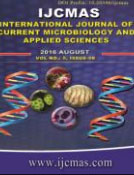


 National Academy of Agricultural Sciences (NAAS)
National Academy of Agricultural Sciences (NAAS)

|
PRINT ISSN : 2319-7692
Online ISSN : 2319-7706 Issues : 12 per year Publisher : Excellent Publishers Email : editorijcmas@gmail.com / submit@ijcmas.com Editor-in-chief: Dr.M.Prakash Index Copernicus ICV 2018: 95.39 NAAS RATING 2020: 5.38 |
Vitiligo is a common skin disease caused by a deficiency in the production of melanocyte. It is a non-contagious disease that affects the general public, without distinction of race, sex. The aim of this study was to find the clinical features and evaluate the association between GSTT1, GSTM1 null genotypes and the development of vitiligo in Dhi Qar province in southern Iraq. This study included 100 vitiligo patients and 90 controls (mean age 32±15.2, 31.8±11.2 respectively). 80% of patients were males while rest 20% were females. Vitiligo does not show any significant association with smoking. 35% patients are associated with the positive family history. 12% cases reported physical trauma as the physical factor. 10% patients were associated with autoimmune disease. Polymerase Chain Reaction PCR was used for the analysis of the study null genotypes. We found that the GSTM1-null might play an important role in risk for vitiligo (OR=1.56; 95%CI =0.88-2.79), and the GSTT1-null genotype was significantly associated with the susceptibility to vitiligo (OR=1.55; 95 % CI= 0.79-3.06). In combined analysis GSTT1, GSTM1 null genotypes showed significant associations with vitiligo susceptibility (OR=2.70; 95%, CI=1.03-7.08).
 |
 |
 |
 |
 |